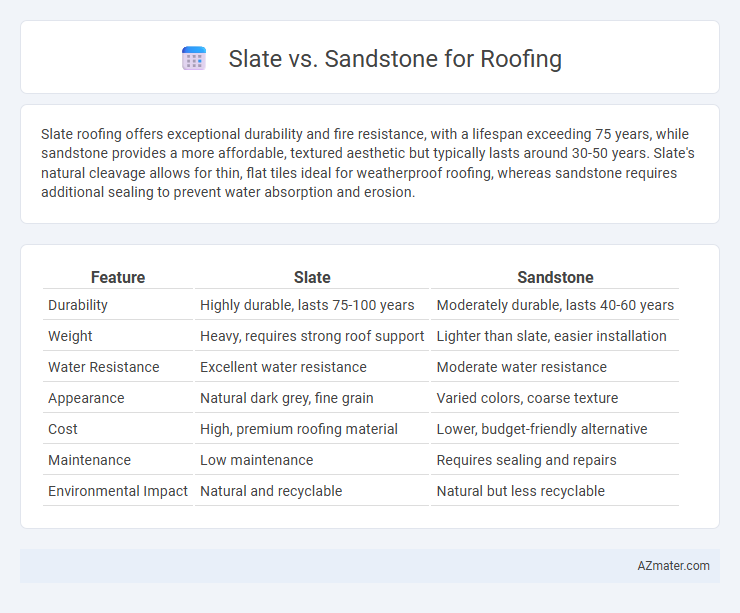Slate roofing offers exceptional durability and fire resistance, with a lifespan exceeding 75 years, while sandstone provides a more affordable, textured aesthetic but typically lasts around 30-50 years. Slate's natural cleavage allows for thin, flat tiles ideal for weatherproof roofing, whereas sandstone requires additional sealing to prevent water absorption and erosion.
Table of Comparison
| Feature | Slate | Sandstone |
|---|---|---|
| Durability | Highly durable, lasts 75-100 years | Moderately durable, lasts 40-60 years |
| Weight | Heavy, requires strong roof support | Lighter than slate, easier installation |
| Water Resistance | Excellent water resistance | Moderate water resistance |
| Appearance | Natural dark grey, fine grain | Varied colors, coarse texture |
| Cost | High, premium roofing material | Lower, budget-friendly alternative |
| Maintenance | Low maintenance | Requires sealing and repairs |
| Environmental Impact | Natural and recyclable | Natural but less recyclable |
Introduction to Slate and Sandstone Roofing
Slate roofing offers exceptional durability and natural elegance, with its fine-grained metamorphic rock composition providing superior resistance to weathering and fire. Sandstone, a sedimentary rock, is valued for its unique textures and warm earthy tones, contributing to aesthetic appeal while requiring proper sealing to enhance resilience. Both materials serve as sustainable roofing options, chosen for their longevity and distinctive architectural character.
Physical Properties Comparison
Slate roofing features a dense, fine-grained metamorphic structure with exceptional durability and natural cleavage, enabling thin, uniform tiles that resist water absorption and weathering. Sandstone, a sedimentary rock composed primarily of quartz and feldspar, typically exhibits greater porosity and lower density, resulting in higher water absorption and reduced frost resistance compared to slate. Slate's lower porosity and superior compressive strength make it a more resilient roofing material, while sandstone may require additional sealing to improve its physical performance in roofing applications.
Durability and Longevity
Slate roofing offers exceptional durability, often lasting over 100 years due to its natural resistance to weathering and fire. Sandstone, while aesthetically pleasing, tends to be less durable and more porous, leading to a shorter lifespan of around 30 to 50 years. The superior density and hardness of slate make it a preferred choice for long-term roofing solutions requiring minimal maintenance.
Weather Resistance and Performance
Slate roofing offers superior weather resistance due to its natural density and low water absorption, making it highly durable against freeze-thaw cycles, heavy rain, and wind. Sandstone, being more porous, tends to absorb moisture, which can lead to faster deterioration and reduced performance in harsh weather conditions. Slate's longevity and minimal maintenance under extreme weather make it a preferred choice for roofing compared to sandstone.
Color and Aesthetic Options
Slate roofing offers a rich palette of natural hues, including deep grays, blues, greens, and purples, providing a timeless and elegant aesthetic. Sandstone roofing tiles typically present warmer earth tones like tans, reds, and browns that complement rustic or Mediterranean architectural styles. The variety in color gradients and textures between slate and sandstone allows homeowners to select a roofing material that enhances their property's visual appeal and suits regional design preferences.
Cost and Installation Differences
Slate roofing typically costs between $15 to $30 per square foot due to its natural durability and aesthetic appeal, while sandstone roofs, being less common, often range from $10 to $20 per square foot. Installation of slate demands skilled labor specialized in handling its heavy, brittle tiles, leading to higher labor costs and longer project timelines; sandstone, with its lighter texture, allows for simpler installation techniques and reduced labor expenses. Cost differences are also influenced by slate's superior longevity, often exceeding 75 years, compared to sandstone's average lifespan of 30 to 50 years.
Maintenance Requirements
Slate roofing requires minimal maintenance due to its natural durability and resistance to weathering, often lasting over a century with proper care. Sandstone roofing, being softer and more porous, demands more frequent inspections and repairs to address potential erosion, cracking, or moss growth. Choosing slate can significantly reduce long-term maintenance costs and efforts compared to sandstone.
Environmental Impact
Slate roofing offers notable environmental benefits due to its natural durability and longevity, often lasting over a century, which reduces the frequency of replacements and waste generation. Sandstone, although aesthetically appealing, tends to be less durable and may require more frequent repairs or replacement, increasing its environmental footprint through resource consumption and landfill contribution. Both materials are natural stones, but slate's superior resistance to weathering and minimal maintenance needs make it a more sustainable choice for eco-conscious roofing projects.
Suitability for Different Climates
Slate roofing offers exceptional durability and resistance to extreme weather, making it ideal for cold, wet climates due to its natural water resistance and freeze-thaw stability. Sandstone, while aesthetically pleasing, tends to be more porous and less durable under heavy rainfall or freezing conditions, making it better suited for arid or mild climates. The choice between slate and sandstone roofing should consider local climate factors such as precipitation, temperature fluctuations, and humidity to ensure longevity and performance.
Choosing the Right Material for Your Roof
Slate and sandstone offer distinct advantages for roofing, with slate known for its durability, water resistance, and lifespan exceeding 100 years, making it ideal for long-term investment in roofing materials. Sandstone provides a unique aesthetic with natural earthy tones and good thermal insulation, but it is generally less durable and more porous, requiring regular maintenance. Choosing the right material depends on climate conditions, budget, and desired architectural style, with slate favored for high-end, durable roofing and sandstone suited for historic or rustic designs.

Infographic: Slate vs Sandstone for Roofing
 azmater.com
azmater.com